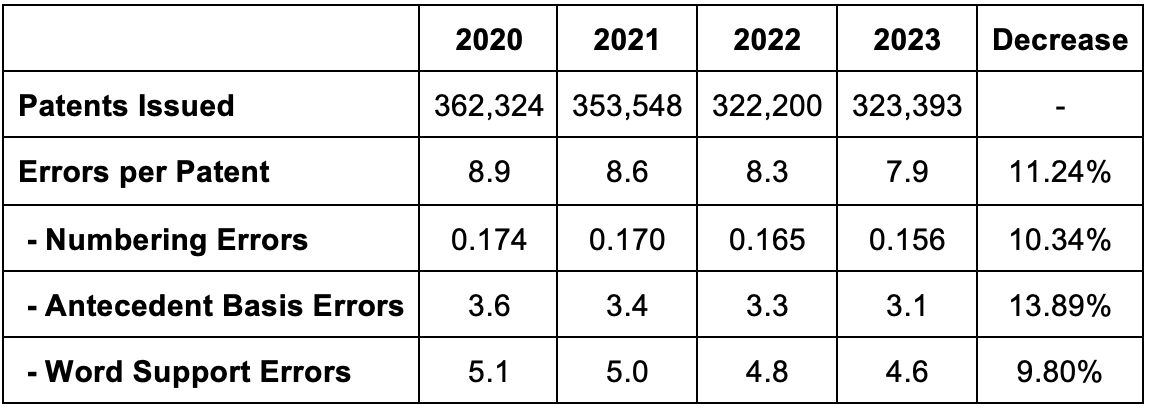Since 2020, Patent Errors Have Decreased by 11.24%
“We can’t be 100% certain of the trend’s cause, but it seems clear that patent error rate is on the decline.”
In an ideal world, issued patents would not contain errors. In reality, patent drafting is tedious and time-consuming work and perfection is not an attainable goal. The patent industry seems to be steadily getting better, though.
In a recent study, we uncovered an 11.24% decrease in errors per patent over the past four years. We observed this decrease by reviewing every patent issued by the U.S. Patent and Trademark Office (USPTO) since 2020 – nearly 1.4 million patents.
Here are the findings:
Temporary Dip or Long-Term Trend?
The steadiness of the decrease year after year across all three types of errors we track indicates a trend. This is not a one-time anomaly. And an 11.2% decrease in just four years is not a small dip. (It would have been interesting to extend our review as far back as 2010 or 2000. Unfortunately, the USPTO data format changes over time and existing tools cannot handle the older data formats).
What Types of Patent Errors are Detectable?
For this study, we focused on three types of errors – numbering errors, antecedent basis errors, and word support errors. These types of errors were selected because (1) they are important errors to avoid and (2) the software can reliably find these errors.
Note that the data only includes “red” errors in the software’s proofreading results. The “yellow” warnings were not included because the warnings are more subjective.
Numbering Errors: 10.3% Decrease Since 2020.
Numbering errors include both claim numbering errors (e.g., skipping a claim number or repeating a claim number) and dependency errors (e.g., a method claim depending from a system claim). Most (and maybe all) of the errors here are dependency errors.
The prevalence of these types of errors is small because they are easier for humans to find. However, they are decreasing as well.
Antecedent Basis Errors: 13.9% Decrease Since 2020.
When claims introduce a term, they should use an indefinite article (“a” or “an”). When claims later refer back to the same term, they should use the definite article (“the”). An antecedent basis error occurs where the claim has a term with “the” but no previous introduction of the same term without “the” was found.
Word Support Errors: 9.8% Decline Since 2020.
Word support errors are claim words where the word or a variant of the word (e.g., store, stores, stored, storing) was not found in the detailed description section of the patent. These are not actually errors, but in my view, it is a very bad practice for claims to use words that are not in the detailed description.
Attorneys Aren’t Perfect … And Neither is Automation.
It is important to note that proofreading tools are not perfect. Any proofreading tool will miss some errors and will mark some things as errors that are not actually errors. With modern machine learning technology, however, the accuracy of proofreading tools is quite high. Although the error counts for any single patent may not be exact, the tools give us a reliable overall view of industry-wide patent quality by reviewing an entire year of issued patents. Of course, we can’t be 100% certain of the trend’s cause, but it seems clear that patent error rate is on the decline.
Disclaimer: The author is founder of Patent Bots, a software tool that is the source of the data provided in this article.
Jeff O’Neill
Jeff O’Neill, Counsel at GTC Law Group, specializes in preparation and prosecution of patent applications in the areas of machine learning, deep neural networks, artificial intelligence, natural language processing, speech […see more]








